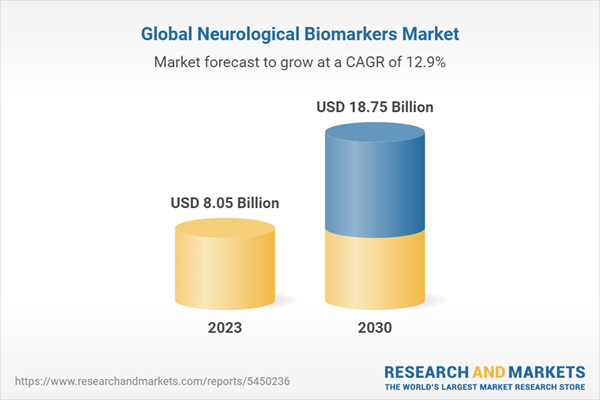Dublin, Jan. 24, 2024 (GLOBE NEWSWIRE) -- The "Global Neurological Biomarkers Market Size, Share & Trends Analysis Report by Application (Alzheimer's, Parkinson's, Multiple Sclerosis, Autism), Type, End-use, Region, and Segment Forecasts, 2024-2030" report has been added to ResearchAndMarkets.com's offering.
The global neurological biomarkers market size is expected to reach USD 18.75 billion by 2030, expanding at a CAGR of 12.89% from 2024 to 2030. Increased funding for R&D of neurological biomarkers to boost development of new drugs is expected to impel market growth. National Institute of Neurological Disorders and Stroke provides funding opportunities such as cooperative agreements & development grants for researchers conducting studies related to clinical validation, analytical validation, & biomarker discovery. 
Biomarkers play a significant role in the development of drugs for the treatment of neurological diseases. In recent years, there has been a significant rise in investments in the R&D of treatments for neurological diseases. For instance, in December 2020, Target ALS-a nonprofit research foundation-announced research funding of USD 15 million for a project focused on the discovery of novel biomarkers for ALS, which is anticipated to accelerate market growth in the forecast period.
Availability of technologically advanced products such as Quanterix Simoa (single-molecule array), which is a digitized ELISA test with a high signal-to-noise ratio. This technology helps overcome blood-brain barrier issues associated with neurological disease-related biomarkers. Such technological advancements are expected to drive market growth. For instance, in January 2021, Abbott introduced the first rapid blood test for traumatic brain injury, including concussion. This test measures a particular protein that is found in the blood after a traumatic brain injury and can be used to rule out the need for CT scanning in case of negative test results.
Factors such as lack of awareness about such diagnostic products & their high cost and limited availability or absence of neurologists, especially in developing & underdeveloped countries, could affect the adoption of such biomarker-based diagnostic solutions. According to a World Federation of Neurology survey of 63/84 WHO member countries, the majority of neurologists in 31/63 countries worked in major cities. One neurologist was serving a population of about 6,240 to 4,750,000.
Neurological Biomarkers Market Report Highlights
- In 2023, proteomic type accounted for the largest market share and is anticipated to maintain their dominance over the forecast period as these are essential for accurate diagnosis of disease onset and progression due to the careful detection of posttranslational modifications and protein signatures
- Parkinson's disease segment held the largest market share owing to rising incidence and increasing R&D activities.
- Based on end use, the research organizations and others segment dominated the neurological biomarkers market. Research organizations collaborating for the development of therapeutics for treating neurological disorders utilize biomarkers for assessing the drug tolerance.
- North America dominated the market owing to presence of market players with strong presence in the U.S. & Canada, and increasing government funding for the development of novel biomarkers
- Asia-Pacific is anticipated to witness significant growth over the forecast period owing to high adoption of technologically advanced diagnostic products in developed countries such as Japan & Australia and increasing adoption of these products in developing economies such as China and India.
Key Attributes:
| Report Attribute | Details |
| No. of Pages | 120 |
| Forecast Period | 2023 - 2030 |
| Estimated Market Value (USD) in 2023 | $8.05 Billion |
| Forecasted Market Value (USD) by 2030 | $18.75 Billion |
| Compound Annual Growth Rate | 12.8% |
| Regions Covered | Global |
Key Topics Covered:
Chapter 1 Methodology and Scope
Chapter 2 Executive Summary
Chapter 3 Neurological Biomarkers Market Variables, Trends, And Scope
3.1 Neurological Biomarkers Market Lineage Outlook
3.1.1 Parent Market Outlook
3.2 Penetration And Growth Prospect Mapping
3.3 Pipeline Analysis
3.3.1 Alzheimer's Disease
3.3.2 Parkinson's Disease
3.3.3 Multiple Sclerosis
3.3.4 Autism Spectrum Disorder
3.4 Market Dynamics
3.4.1 Market Driver Analysis
3.4.1.1 Increasing Prevalence Of Neurological Diseases
3.4.1.2 Technological Advancements
3.4.1.3 Increased Funding For R&D In Biomarkers
3.4.2 Market Restraint Analysis
3.4.2.1 Lack Of Consumer Awareness
3.4.2.2 Reimbursement Policies
3.5 Neurological Biomarkers: Market Analysis Tools
3.5.1 Industry Analysis - Porter's Five Forces
3.5.2 Pestle Analysis
Chapter 4 Neurological Biomarkers Market: Segment Analysis, By Type, 2018-2030 (USD Million)
4.1 Neurological Biomarkers Market: Type Movement Analysis
4.1.1 Genomic
4.1.2 Proteomic
4.1.3 Metabolomic
4.1.5 Imaging
4.1.6 Others
Chapter 5 Neurological Biomarkers Market: Segment Analysis, By Application, 2018-2030 (USD Million)
5.1 Neurological Biomarkers Market: Application Movement Analysis
5.1.1 Alzheimer's Disease
5.1.2 Parkinson's Disease
5.1.3 Multiple Sclerosis
5.1.4 Autism Spectrum Disorder
5.1.5 Others
Chapter 6 Neurological Biomarkers Market: Segment Analysis, By End-use, 2018-2030 (USD Million)
6.1 Neurological Biomarkers Market: End-use Movement Analysis
6.1.1 Hospital & Hospital Laboratories
6.1.2 Independent Clinical Diagnostic Centers
6.1.3 Research Organizations And Others
Chapter 7 Neurological Biomarkers Market: Segment Analysis, By Region, 2018-2030 (USD Million)
Chapter 8 Neurological Biomarkers Market: Competitive Analysis
- Abbott
- Johnson & Johnson Services
- Bio-Rad Laborotories
- Alseres Pharmaceuticals
- Banyan Biomarkers
- Rules-Based Medicine
- Thermo Fisher Scientific
- Diagenic
- Merck
- Quanterix
For more information about this report visit https://www.researchandmarkets.com/r/wf5dd4
About ResearchAndMarkets.com
ResearchAndMarkets.com is the world's leading source for international market research reports and market data. We provide you with the latest data on international and regional markets, key industries, the top companies, new products and the latest trends.
Attachment
